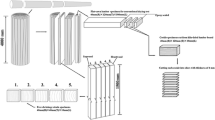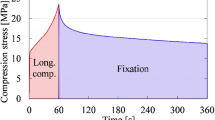Abstract
This work presents the experimental study of natural drying and cracking of green wood slices of two tropical species. The tests were carried out on slices of Aucoumea klaineana P. and Pterocarpus soyauxii at uncontrolled temperature and relative humidity. To follow the strains, specifical targets were drawn on the slice in the radial and circular directions. The slice was placed in front of a camera to record the mass loss on a control specimen and to follow the displacement of the targets on a regular basis until the end of the tests. As results, the evolutions of radial and tangential displacements were calculated in a cylindrical coordinate and the fiber saturation point was deduced accordingly. In addition, the initiation and the crack propagation were followed in a green wood slice subjected to natural drying. At the end, finite element model was developed, and the obtained results were compared to experimental data. The results help to better understand and anticipate the behavior of green wood slices during desiccation. In addition, the potential areas of appearance and propagation of cracks were identified to reduce and prevent defects resulting from the primary processing of wood.




















Similar content being viewed by others
Abbreviations
- FEM:
-
Finite element method
- FSP:
-
Fiber saturation point
- MC:
-
Moisture content
- RH:
-
Relative air humidity
- Pdk:
-
Paduk
- Ok:
-
Okume
- i or j/ij/kl:
-
Different directions of the woody plane (R,T,L) or number 1, 2, 3
- Mij–MijC:
-
Numerical calculus between two targets (ray)
- Mij–MijB:
-
Numerical calculus between two targets (crown)
- Mij–Mkl :
-
Experimental calculus between two targets (ray and crown)
- Eij / i :
-
Moduli of elasticity
- S ij :
-
Corrected components of the complacency
- ( S ij ) :
-
Complacency from Guitard equations
- J ( i ) :
-
Total shrinkage
- a ij/b ij :
-
Constants
- Ci :
-
Crowns
- Ri :
-
Radii
- GRT :
-
Shear moduli
- νij :
-
Poisson’s coefficients
- α i :
-
Shrinkage/swelling coefficients
- αv :
-
Volumetric shrinkage
- ε:
-
Strain
- ε r/ε(r):
-
Radial strain
- ε t/ε(t):
-
Tangential strain
- U r :
-
Radial displacement
- U t/θ :
-
Tangential displacement
- σ:
-
Stress
- θ :
-
Angular deviation between two Ri
- d 0 :
-
Relative depth
- d crack :
-
Depth crack
- r d :
-
Radius for the calculation of tangential strains
- R 0 :
-
Ray
- ρ:
-
Mass density
- ρ 0 :
-
Anhydrous density
- ρw :
-
Wet density
- Ow :
-
Wet okume
- Od :
-
Dry okume
- Pw :
-
Wet Paduk
- Pd :
-
Dry Paduk
- M w :
-
Mass
- M 0 :
-
Anhydrous mass
- β :
-
Isotropic stress
- K β :
-
Constant of β
- W/w:
-
Moisture content
- W f :
-
Final moisture content
- T :
-
Temperature
- e :
-
Thickness
- v :
-
Volume
- m:
-
Mass in grams
- m :
-
Propagation speed
- d :
-
Diameter
- u :
-
Unauthorized displacement
- r :
-
Unauthorized rotation
- r:
-
Distance between two targets on Ri
- S:
-
Standard deviation
References
Angellier N, Pitti RM, Dubois F (2016) Crack analysis of wood under climate variations. In: Beese A, Zehnder A, **a S (eds) Fracture, fatigue, failure and damage evolution, volume 8. Conference Proceedings of the society for experimental mechanics series. Springer, Cham. https://doi.org/10.1007/978-3-319-21611-9_29
Bouet C (1980) The Okume Saga. Human Sciences, ORSTOM, XVII (3–4):269–272
Chassagne P, Bou-Saïd E, Jullien JF, Galimard P (2005) Three dimensional creep model for wood under variable humidity-numerical analyses at different material scales. Mech Time Depend Mater 9(4):203–223. https://doi.org/10.1007/s11043-005-9001-y
Chen K, Qiu H, Sun M, Lam F (2019) Experimental and numerical study of moisture distribution and shrinkage crack propagation in cross section of timber members. Constr Build Mater 221:219–231. https://doi.org/10.1016/j.conbuildmat.2019.05.191
Choong E, Achmadi S (1991) Effects of extractives on moisture sorption and shrinkage in tropical woods. Wood Fiber Sci 23(2):185–196
CIRAD (2012a) http://tropix.cirad.fr/FichiersComplementaires/FR/Afrique/OKOUME.pdf. Accessed 1 Sept 2021
CIRAD (2012b). https://tropix.cirad.fr/FichiersComplementaires/FR/Afrique/PADOUK.pdf. Accessed 1 July 2022
Dietsch P, Gamper A, Merk M, Winter S (2015) Monitoring building climate and timber moisture gradient in large-span timber structures. J Civ Struct Health Monit 5(2):153–165. https://doi.org/10.1007/s13349-014-0083-6
El Hachem C, Abahri K, Bennacer R (2019) Original experimental and numerical approach for prediction of the microscopic hygro-mechanical behavior of spruce wood. Constr Build Mater 203:258–266. https://doi.org/10.1016/j.conbuildmat.2019.01.107
Esteban M, Arriaga F, Íñiguez G, Bobadilla I, Mateo R (2010) Influencia de las fendas en la resistencia de la madera estructural. Materiales De Construccion 60(299):115–132. https://doi.org/10.3989/mc.2010.48208(Influence of cracks on the strength of structural timber)
Guitard D, El Amri F (1987) Modèles prévisionnels de comportement élastique tridimensionnel pour les bois feuillus et les bois résineux. Ann Sci for 44(3):335–358. https://doi.org/10.1051/forest:19870305(Predictive models of three-dimensional elastic behaviour for hardwoods and softwoods)
Hernandez RE, Passarini L, Koubaa A (2014) Effects of temperature and moisture content on selected wood mechanical properties involved in the chip** process. Wood Sci Technol 48:1281–1301. https://doi.org/10.1007/s00226-014-0673-9
Jullien D, Gril J (1996) Mesures des déformations bloquées dans un disque de bois vert, Méthode de la fermeture. Ann Sci for 53(5):955–966. https://doi.org/10.1051/forest:19960504(Measurement of locked deformations in a green wood disc, Closing method.)
Kohlhauser C, Hellmich C (2012) Determination of Poisson’s ratios in isotropic, transversely isotropic, and orthotropic materials by means of combined ultrasonic-mechanical testing of normal stiffnesses: application to metals and wood. Eur J Mech A Solids 33:82–98. https://doi.org/10.1016/j.euromechsol.2011.11.009 (ISSN 0997-7538)
Larsen F, Ormarsson S (2013) Numerical and experimental study of moisture-induced stress and strain field developments in timber logs. Wood Sci Technol 47:837–852. https://doi.org/10.1007/s00226-013-0541-z
Montéro C, Burgers A, Arnould O, Wattrisse B, Gril J (2016) Prise en compte de l'anisotropie dans la détermination des coefficients de variations hygroscopiques des bois. In: 5èmes journées du GDR Sciences du Bois-Les usages du bois: enjeux et opportunités. (Consideration of anisotropy in the determination of coefficients of hygroscopic variation in wood). In: 5th days of the GDR Sciences du Bois-The uses of wood: challenges and opportunities.)
Moutou Pitti R (2008) Découplage des modes mixtes de rupture dans les matériaux viscoélastiques orthotropes : modélisation et expérimentation. Doctoral thesis, Limoges. (Decoupling of mixed modes of failure in orthotropic viscoelastic materials: modelling and experimentation)
Moutou Pitti R, Dubois F, Sauvat N, Fournely E (2013) Strain analysis in dried green wood: experimentation and modelling approaches. Eng Fract Mech 105:182–199. https://doi.org/10.1016/j.engfracmech.2013.04.002
Mvondo RRN, Meukam P, Jeong J, Meneses DDS, Nkeng EG (2017) Influence of water content on the mechanical and chemical properties of tropical wood species. Results Phys 7:2096–2103. https://doi.org/10.1016/j.rinp.2017.06.025
Navi P, Heger F (2005) Comportement thermo-hydromécanique du bois : applications technologiques et dans les structures. PPUR presses polytechniques. (Thermo-hydromechanical behaviour of wood: technological and structural application.)
Nguyen SL, Saifouni O, Moutou R, Destrebecq JF, Garmy J (2013) Analyse numérique des contraintes internes dans les éléments en bois contrecollés sous humidité variable. 31st AUGC Meeting, ENS Cachan (numerical analysis of internal stresses in glued wood elements under variable humidity)
Ndong Meye SL, Moutou Pitti R, Ekomy Ango S, Ikogou S (2015) Mechanical behavior of Okoumé (Aucoumea Klaineana) under drying process. 4èmes journées du GDR 3544 « Sciences du bois », Clermont-Fd, November 4- 6, 2015. https://doi.org/10.13140/RG.2.1.4578.1200
Odounga B, MoutouPitti R, Toussaint E, Grédiac M (2018) Mode I fracture of tropical woods using grid method. Theor Appl Fracture Mech 95:1–17. https://doi.org/10.1016/j.tafmec.2018.02.006 (ISSN 0167-8442)
Oteng-Amoako AA, Brink M, Oyen LPA, Cobbinah JR, Siemonsma JS (2008) Ressources végétales de l'Afrique tropicale 7 (1) Bois d'œuvre (Plant Resources of Tropical Africa 7(1) Timber)
Palka LC (1973) Predicting the effect of specific gravity, moisture content, temperature and strain rate on the elastic properties of softwoods. Wood Sci Technol 7(2):127–141. https://doi.org/10.1007/BF00351155
Pambou Nziengui CF, Ikogou S, Moutou Pitti R (2018) Impact of cyclic compressive loading and moisture content on the mechanical behavior of Aucoumea Klaineana Pierre. Wood Mater Sci Eng 13(4):190–196. https://doi.org/10.1080/17480272.2017.1307281
Pambou Nziengui CF, Moutou Pitti R, Fournely E, Gril J, Godi G, Ikogou S (2019) Notched-beam creep of Douglas fir and white fir in outdoor conditions: experimental study. Constr Build Mater 196:659–671. https://doi.org/10.1016/j.conbuildmat.2018.11.139
Preziosa C, Guitard D, Sales C (1986) Contraintes internes de séchage dans le matériau bois: le tenseur des coefficients de contraintes de séchage comme caractéristique isotrope de la matière ligneuse. In: Physique-Mécanique-Rhéologie du bois. CIRAD-CTFT. Nogent-sur-Marne: CIRAD-CTFT, 91–109. (Cahiers scientifiques : CTFT, 8) ISBN 2-85-411-001-3 (Internal drying stresses in wood material: the tensor of drying stress coefficients as an isotropic characteristic of the wood material. In: Physics-Mechanics-Rheology of Wood) ISBN 2-85-411-001-3)
Raponda-Walker A, Sillans R (1961) Les plantes utiles du Gabon. Q J Crude Drug Res 1(1):27 (The useful plants of Gabon)
Rémond R, Passard J, Perré P (2007) The effect of temperature and moisture content on the mechanical behavior of wood: a comprehensive model applied to drying and bending. Eur J Mech A Solids 26(3):558–572. https://doi.org/10.1016/j.euromechsol.2006.09.008 (ISSN 0997-7538)
Ross RJ (2010) Wood handbook: wood as an engineering material. Centennial ed. General technical report FPL; GTR-190. Madison, WI: U.S. Dept. of Agriculture, Forest Service, Forest Products Laboratory, 2010: 1 v. https://doi.org/10.2737/FPL-GTR-190
Schmidt EL, Riggio M, Barbosa AR, Mugabo I (2019) Environmental response of a CLT floor panel: lessons for moisture management and monitoring of mass timber buildings. Build Environ 148:609–622. https://doi.org/10.1016/j.buildenv.2018.11.038
Skaar C (1988) Wood-water relations. Springer, New York
Varnier M (2019) Deferred thermo-hygro-mechanical behaviour of hardwoods: from wood science to engineering. Civil Engineering. University of Limoges. French. ⟨NNT: 2019LIMO0035⟩. ⟨tel-02303304⟩
You R, Zhu N, Deng X, Wang J, Liu F (2021) Variation in wood physical properties and effects of climate for different geographic sources of Chinese fir in subtropical area of China. Sci Rep 11(1):1–11. https://doi.org/10.1038/s41598-021-83500-w
Acknowledgements
The authors would like to thank the laboratories of the Technological Research Institute (IRT) and the Tropical Ecology Research Institute (IRET) of the National Center for Scientific and Technological Research (CENAREST_GABON) for their welcome and logistical assistance. However, this research did not receive any specific grant from funding agencies in the public, commercial, or not-for-profit sectors.
Author information
Authors and Affiliations
Corresponding author
Additional information
Publisher's Note
Springer Nature remains neutral with regard to jurisdictional claims in published maps and institutional affiliations.
Rights and permissions
Springer Nature or its licensor holds exclusive rights to this article under a publishing agreement with the author(s) or other rightsholder(s); author self-archiving of the accepted manuscript version of this article is solely governed by the terms of such publishing agreement and applicable law.
About this article
Cite this article
Nkene Mezui, E., Pambou Nziengui, C.F., Moutou Pitti, R. et al. Strain and cracks investigations on tropical green wood slices under natural drying: experimental and numerical approaches. Eur. J. Wood Prod. 81, 187–207 (2023). https://doi.org/10.1007/s00107-022-01881-9
Received:
Accepted:
Published:
Issue Date:
DOI: https://doi.org/10.1007/s00107-022-01881-9




